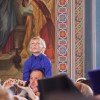1. Orthodoxy
THE ORTHODOX CRURCH is the unity of faith and love (St. Ignatius of Antioch) of all Churches which have preserved Orthodoxy , i.e., the Tradition of Faith, Order, Worship and Piety, as confessed from the beginning “everywhere, always and by all.” And, although historically she was for a long time confined to the Eastern part of Christendom after the separation of the Christian West from her, the Orthodox Church rejects the idea that hers is a “partial” or “oriental” expression of the Christian faith. On the contrary, she confesses her faith to be full, catholic, and universal. She sees herself as the One, Holy, Catholic and Apostolic Church.
The Tradition of Faith stems from Divine Revelation as recorded in Holy Scriptures and understood and interpreted by the Church in the continuity of her teaching ministry: by her Councils, Fathers, Teachers, Saints, by her worship and by the whole of her Divinely inspired life. Of especial normative character are the dogmatical and canonical decisions of the Seven Ecumenical and Ten local Councils, the writings of the Holy Fathers, the testimony of the liturgical and iconographic tradition and the universal consensus of doctrine and practice.
The Tradition of Order is based on the unbroken continuity of the Ministry and, above all, on the Apostolic succession of Bishops who are, in each Church, the guardians of the catholic fullness of faith and the Divinely appointed bearers of the Church’s priestly, pastoral and teaching power and authority. Their unity expresses the unity of the Church; their agreement is the voice of the Holy Spirit. They govern the Church, and in this they are helped by the priests and deacons. They are also helped by the whole body of the Church, for, according to Orthodox teaching, all the faithful are entrusted with responsibility for the purity of faith. Church order is preserved in the Holy Canons, which constitute an integral part of Tradition.
The Tradition of Worship includes the seven Sacraments: Baptism, Chrismation, Eucharist, Holy Orders, Matrimony, Unction and Pennance; the order of the daily, weekly and yearly cycles of prayers; the Fasts and Feasts; the commemoration and veneration of the Mother of God, the Saints and the Angels; the veneration of Holy Icons; the prayers for the departed members of Christ’s Body; the sanctification — through rites of blessing and intercession — of all human life as life in Christ.
The Tradition of Piety is expressed primarily in the lives, achievements and teachings of the Saints who bear witness to the presence and action of the Holy Spirit in the Church and are, therefore, our guides and helpers on the way to the Kingdom of God.
All those — individuals, groups or churches — who reject the whole or any part of this Tradition, who deform it or deviate from it, are, according to the teaching of the Orthodox Church, alien to Orthodoxy and cannot be admitted to the Sacraments, for these are the signs and the fulfillment of the Church as unity of faith and love .
2. The Orthodox Churches
The following Orthodox Churches exist at present: the four ancient Patriarchates of Constantinople, Antioch, Alexandria, and Jerusalem; the national Churches of Russia, Greece, Serbia, Georgia, Bulgaria, Roumania, Poland, Czechoslovakia, Albania, and the Churches of Cyprus and Sinai. Each of these is autocephalous, i.e., independent in its hierarchical and administrative structure and united to other Churches by the identity of Tradition and communion in Sacraments. The Ecumenical Patriarch of Constantinople is recognized as the first bishop among equals and has the primacy of honor. Each autocephalous Church, in turn, has its Primate who assures its unity with all other Churches.
3. The Russian Church
Russia became an Orthodox country in 988, when the Prince of Kiev, St. Vladimir, invited missionaries from Constantinople to baptize his people. Although at first the Russian Church was a Metropolia of the Patriarchate of Constantinople (she was granted autocephaly and became a Patriarchate in 1596), the Russians could, from the very beginning, worship God in their own language. They used the Slavonic translations of the Bible and the liturgical texts made in the 9th century by two Greek missionaries to the Western Slavs, SS Cyril and Methodius. Rich in Saints, beautiful churches, monasteries and icons, the Russian Church became, after the fall of Constantinople in 1453, and the loss of independence by nearly all Orthodox countries, the defender of Orthodox people living under Islam and a center of Orthodox culture and learning. It sent missionaries, not only to Siberia, but also to Japan, Korea and America.
In 1917, after the Communist Revolution, there began a bloody persecution of the Church. Thousands of bishops, priests and laymen were executed or perished in concentration camps. Thousands of Churches were destroyed or closed and the Church was deprived of any possibility to teach and propagate her faith. In spite of this persecution, the Church survived, and during World War II, was given certain limited rights. However, she is still under full control of the Communist government and her whole life is confined to worship. She has no access to schools, press or any other possibility of evangelism and is under constant attack on the part of state-supported atheistic propaganda.
4. Orthodoxy in America
At the end of the 18th century, the Orthodox faith was brought to Alaska, then a Russian territory, by a group of Russian monks from Valamo. They converted the Aleuts and in 1848 the first Bishopric was established in Sitka. From Alaska it spread along the Pacific Coast and then moved to the East, encountering a wave of Orthodox immigration that began in the second part of the 19th century. Prior to World War I, all Orthodox parishes, regardless of their national origin, were under the canonical jurisdiction of the Russian Church, forming a Diocese with the Bishop, who, since 1906, resided in New York. After the war, virtually every ethnic group formed its own Diocese with direct dependence on its national mother-Church in the Old World. The years 1920-39 were the peak of this acute “nationalisation” of Orthodoxy in America. There existed, in the U.S.A. and Canada, more than ten Orthodox jurisdictions which, although in communion with one another, maintained very loose contacts among themselves. After World War II the need for cooperation, the challenge of a new generation — American born and American educated — and many other factors raised the inescapable question of greater unity. Three years ago, after several unsuccessful attempts, a first concrete step was taken with the establishment of The Standing Conference of Orthodox Bishops in America.
5. The Russian Metropolia
It was the Revolution of 1917 and the Communist control of the Church following it that forced the Russian Diocese in America to proclaim a temporary independence from the Moscow Patriarchate at the Detroit Sobor of 1924. In doing so, the Russian Church here was applying the historic decisions of the Great Russian Sobor held in Moscow in 1917-18, whose basic tendency was to return from the centralised and bureaucratic Church administration, established by Peter the Great, to the original Orthodox “sobornost” — the active participation of the whole Church — bishops, clergy and laity — in the totality of the Church’s life. Literally following the decisions of the Moscow Sobor, the American Russian Diocese elected its Primate, Metropolitan Platon (+1934), one of the senior Bishops of the Church of Russia who, having served in America before World War I, knew the needs of the Church here and could assure the continuity of her life. The Church, weakened by the Revolution, gathered around Metropolitan Platon and began its new growth. Under his successors, Metropolitans Theophilus (+1950) and Leonty (elected in 1950), new dioceses were created so that today the former Diocese had developed into a great Metropolitan District with nine dioceses. It has theological schools, a system of religious education, etc. It is governed, according to the canonical tradition of the Orthodox Church, by a Synod (Council) of Bishops, led by the Primate, and by a regular triennial Sobor with the participation of clergy and laity. It maintains close relations with all other Orthodox Churches in America and abroad.
Unfortunately, the genuine canonicity of the Metropolia, its organic continuity with the whole growth of Orthodoxy in America, its faithfulness to the very spirit of the Moscow decisions of 1917-18, are not understood and accepted by all. Two other Russian ecclesiastical groups maintain a separate existence, breaking the much needed unity of the Church. One takes its stand on a purely formal “canonicity.” This is the Exarchate of the Moscow Patriarchate, organized in 1933 after the arrival of Archbishop Benjamin from Europe. Its claims are unacceptable to the Metropolia which wants to be in communion with the Orthodox people of Russia, but which cannot depend on a Church administration totally controlled by the Communist regime. The other is the Russian Church in Exile grouping mainly the political emigrants and deeply conditioned in its life by their political ideologies.
The past of the Russian Church in America justifies its present and indicates the direction for the future: faithfulness to all eternal values of Russian Orthodoxy, among which the most essential has always been that of a missionary zeal, the desire to incarnate and to fulfill the Orthodox faith wherever God wants us to be His servants.
Year Book And Church Directory Of The Russian Orthodox Greek Catholic Church Of America (Metropolia) , New York, N.Y., 1963, pp. 7-11















